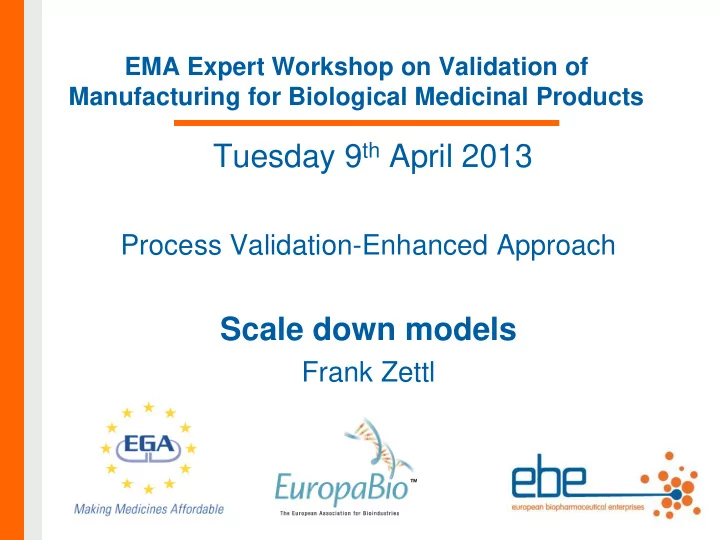

EMA Expert Workshop on Validation of Manufacturing for Biological Medicinal Products Tuesday 9 th April 2013 Process Validation-Enhanced Approach Scale down models Frank Zettl
Key elements enhanced approach • Extensive and intensive process knowledge • Better prediction of scale effects • Leverage process knowledge into control strategy via continuous process verification 2
Scale Down Model (SDM) Lifecycle • Within development • Continuous improvement Design • Compare outputs • Assess suitability Qualify • Facility changes • New CQAs Maintain 3
SDM Design • SDM useful during design phase - Process development and characterization - Process validation (e.g. Virus removal) • Design Options - Whole unit operation models - Cover specific aspects of a unit operation - Worst case model • Relevant outputs are defined (e.g. CQA) • Based scientific and engineering principles • Inputs and environment are considered 4
Typical Model Systems Purification Lab system Robotic system Production Column volume Column volume Column volume ~ 0.2 – 0.6 ml 5 ~ 15 – 25 ml ~ 150 – 400 L
Typical Model Systems – Cell culture 1 0 – 1 5 m L scale Viable cell density VCD 2 L Lab system 6 Process time
Benefits of using SDM • SDM can be extremely useful even if they do not exactly match large scale performance, provided the differences are understood • A large number of process parameters can be explored in large ranges • Several process parameter can be varied independently in a systematic manner • Interactions and quadratic effects can be identified • “Categorical variables” (like raw material lots) can be investigated 7
Qualification of SDM • Statistical approach is gold standard • But effort may vary based on - Availability of manufacturing scale batches - Applied control strategy - Predictions that are made from SDM • A generic qualification should be possible - Depending on understanding of scale effects - Depending on control strategy • Concurrent (re-)validation should be possible 8
Equivalence Testing (TOST) • Contains information about - Observed offset between scales - Observed variability • Equivalence margin is defined based on scientific considerations Difference in means • SDM containing non- between scales equivalent results may still Confidence interval of difference be suitable Equivalence margin Line of zero difference 9
Suitability of Scale Down Models • Even if not statistical equivalent • Depend on intended use • Offsets may be applied • Scientifically explained • Verified with independent data • Observed variability can be de-risked • Worst case studies • Control strategy (including in-process testing, specification testing, stability etc.) 10
Process Models • Mathematical description of input/output relationship • Result from univariate and multivariate experimentation • Can cover interactions and quadratic effects • Are assessed with regard to their quality - Coverage of data - Prediction quality • Estimate value of process outputs and the confidence of prediction • Process models cannot be verified over the entire range at scale • But can be assessed within monitoring program 11
The Process Modeling Approach Scale down model Manufacturing scale SDM Qual Control Output space attribut Equivalence margin Input Parameter Input Parameter Will be adressed by Process model Output continued process attribut verification extrapolation 12 Input Parameter Input Parameter
Process Models - Limitations • In many cases not all parameters can be investigated in a single study • Categorical variables are difficult (if not impossible) to model • Continued Process Verification and control strategy will overcome potential issues related to this 13
At scale verification - Limitations • Statistical verification is not achievable Error Std Dev Power Alpha 1 0.8 0.050 20 Example IEC- HPLC Peak • 15 SD (@ scale) = 5% • Sample Size 10 Delta model prediction • = 2% 50 0 0.0 0.1 0.2 0.3 0.4 0.5 0.6 0.7 0.8 0.9 1.0 => 199/2 batches needed Difference 14
The Enhanced Approach Team Deborah Baly Bayer Bob Kuhn Amgen Norbert Hentschel Boehringer Ingelheim Brendan Hughes BMS Enda Moran Pfizer Luis Maranga BMS Frank Zettl Roche Karl-Heinz Schneider Bayer Kris Barnthouse Janssen (J&J) Gilles Borrelly Sanofi Camilla Kornbeck Novo Nordisk Markus Goese Roche 15
• THANK YOU 16
Recommend
More recommend